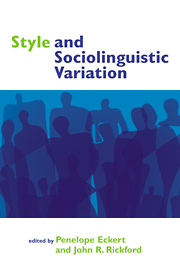Book contents
- Frontmatter
- Contents
- List of figures
- List of tables
- List of contributors
- Acknowledgments
- Introduction: John R. Rickford and Penelope Eckert
- Part I Anthropological approaches
- 1 “Style” as distinctiveness: the culture and ideology of linguistic differentiation
- 2 Variety, style-shifting, and ideology
- 3 The ethnography of genre in a Mexican market: form, function, variation
- 4 The question of genre
- Part 2 Attention paid to speech
- Part 3 Audience design and self-identification
- Part 4 Functionally motivated situational variation
- References
- Index
2 - Variety, style-shifting, and ideology
Published online by Cambridge University Press: 07 December 2009
- Frontmatter
- Contents
- List of figures
- List of tables
- List of contributors
- Acknowledgments
- Introduction: John R. Rickford and Penelope Eckert
- Part I Anthropological approaches
- 1 “Style” as distinctiveness: the culture and ideology of linguistic differentiation
- 2 Variety, style-shifting, and ideology
- 3 The ethnography of genre in a Mexican market: form, function, variation
- 4 The question of genre
- Part 2 Attention paid to speech
- Part 3 Audience design and self-identification
- Part 4 Functionally motivated situational variation
- References
- Index
Summary
Judith Irvine (this volume, chapter 1) has examined the role of ideology in the relation between social group language differences and the representation of those differences in each speaker's style contrasts. Her focus is on the social meanings signified by styles, which are primarily contrastive. She is interested, then, not in what Labov (Labov 1966) called indicators, which she calls “empirical distributions,” but in ideas about language categories that represent social contrasts to participants.
Her paper makes some powerful and important integrative claims. The principle of iconization is a claim that the social contrasts that are imputed to groups or to situations are also represented by linguistic features. Wolof speakers have an account of language features that supports iconization, using the underlying trait explanation. That is, beliefs about contrasts in the traits of groups of people are consistent with contrasts in linguistic features, and these correspond to stylistic selections when traits are expressed by individuals. Iconization could create an arbitrary relation of trait to feature, “historical, contingent, or conventional,” but in the Wolof case, the relation appears not to be arbitrary, but to have some naturalness, and the term “icon” implies a likeness.
Korean and Japanese politeness levels provide another example, besides the Javanese case scrutinized with care by Irvine. Here the higher the deference, the more the effort put into morphology, and the less rough the language is felt to be. A person ignorant of these two languages might still guess that the longer form is the more deferential.
- Type
- Chapter
- Information
- Style and Sociolinguistic Variation , pp. 44 - 56Publisher: Cambridge University PressPrint publication year: 2002
- 12
- Cited by

